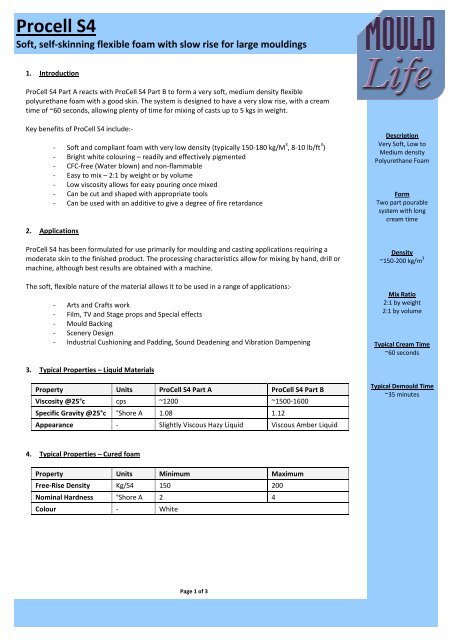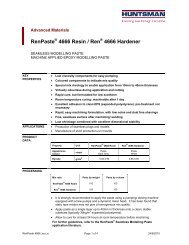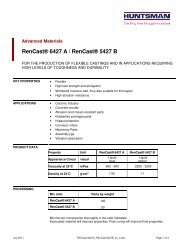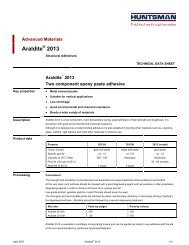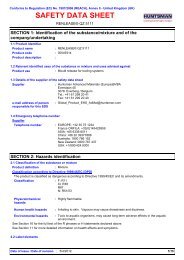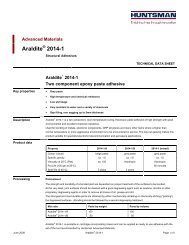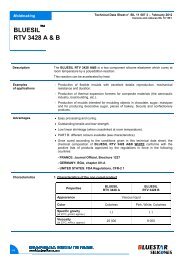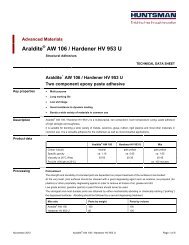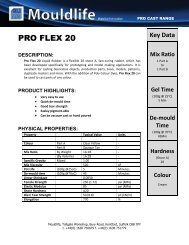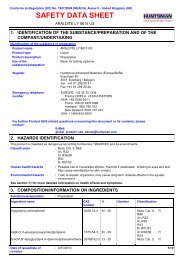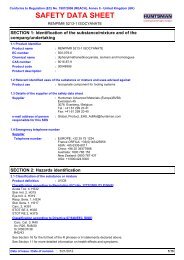Procell S4 - Mouldlife
Procell S4 - Mouldlife
Procell S4 - Mouldlife
Create successful ePaper yourself
Turn your PDF publications into a flip-book with our unique Google optimized e-Paper software.
<strong>Procell</strong> <strong>S4</strong><br />
Soft, self-skinning flexible foam with slow rise for large mouldings<br />
1. Introduction<br />
ProCell <strong>S4</strong> Part A reacts with ProCell <strong>S4</strong> Part B to form a very soft, medium density flexible<br />
polyurethane foam with a good skin. The system is designed to have a very slow rise, with a cream<br />
time of ~60 seconds, allowing plenty of time for mixing of casts up to 5 kgs in weight.<br />
Key benefits of ProCell <strong>S4</strong> include:-<br />
- Soft and compliant foam with very low density (typically 150-180 kg/M 3 , 8-10 lb/ft 3 )<br />
- Bright white colouring – readily and effectively pigmented<br />
- CFC-free (Water blown) and non-flammable<br />
- Easy to mix – 2:1 by weight or by volume<br />
- Low viscosity allows for easy pouring once mixed<br />
- Can be cut and shaped with appropriate tools<br />
- Can be used with an additive to give a degree of fire retardance<br />
2. Applications<br />
ProCell <strong>S4</strong> has been formulated for use primarily for moulding and casting applications requiring a<br />
moderate skin to the finished product. The processing characteristics allow for mixing by hand, drill or<br />
machine, although best results are obtained with a machine.<br />
The soft, flexible nature of the material allows it to be used in a range of applications:-<br />
- Arts and Crafts work<br />
- Film, TV and Stage props and Special effects<br />
- Mould Backing<br />
- Scenery Design<br />
- Industrial Cushioning and Padding, Sound Deadening and Vibration Dampening<br />
Description<br />
Very Soft, Low to<br />
Medium density<br />
Polyurethane Foam<br />
Form<br />
Two part pourable<br />
system with long<br />
cream time<br />
Density<br />
~150-200 kg/m 3<br />
Mix Ratio<br />
2:1 by weight<br />
2:1 by volume<br />
Typical Cream Time<br />
~60 seconds<br />
3. Typical Properties – Liquid Materials<br />
Property Units ProCell <strong>S4</strong> Part A ProCell <strong>S4</strong> Part B<br />
Viscosity @25°c cps ~1200 ~1500-1600<br />
Specific Gravity @25°c °Shore A 1.08 1.12<br />
Appearance - Slightly Viscous Hazy Liquid Viscous Amber Liquid<br />
Typical Demould Time<br />
~35 minutes<br />
4. Typical Properties – Cured foam<br />
Property Units Minimum Maximum<br />
Free-Rise Density Kg/<strong>S4</strong> 150 200<br />
Nominal Hardness °Shore A 2 4<br />
Colour - White<br />
Page 1 of 3<br />
<strong>Mouldlife</strong> Ltd., Miro House, Western Way (West), Bury St Edmunds, Suffolk, IP33 3SP<br />
Telephone: 01638 750 679 Fax: 01638 751 779 Web: www.Mouldlfe.co.uk
5. Reactivity<br />
Property Typical Value Units<br />
Cream Time (100g @ 20°C) 60-90 Seconds<br />
Rise Time (100g @ 20°C) 3-4 Minutes<br />
Tack Free Time (100g @ 20°C) 12-15 Minutes<br />
De-mould Time (Mould @ 35°C) ~35 Minutes<br />
Full Cure (100g @ 20°C) 12-24 Hours<br />
6. Mix Ratios<br />
ProCell <strong>S4</strong>A<br />
ProCell <strong>S4</strong>B<br />
By Weight 2 parts 1 part<br />
By Volume 2 parts 1 part<br />
7. Instructions for use – Preparation for mixing<br />
1. Select an appropriate mixing container:-<br />
a. The container should be clean and dry and capable of holding twice the mix quantity.<br />
b. Ideally should be Polyethylene – this will allow re-use.<br />
2. Prepare the mould or item to be filled:-<br />
a. If moulding in a sealed chamber, then ENSURE YOU HAVE TAKEN ACCOUNT OF THE PRESSURES LIKELY<br />
TO BE GENERATED!<br />
b. Ensure the mould or item to be filled is clean and dry.<br />
c. Use a wax release agent if it is necessary to de-mould the item after cure.<br />
d. If possible, ensure the mould is warm – ideally 20-25°c.<br />
3. Prepare the mixing equipment (whether mixing by hand or drill):-<br />
a. Ensure spatulas or mixers are clean and dry and suitable for the quantity to be mixed.<br />
b. If using a drill, ensure it is set to an appropriate and safe speed.<br />
c. Ideally should be Polyethylene – this will allow re-use.<br />
8. Instructions for use – Mixing and moulding<br />
1. Having previously calculated the amount of foam required (see section 10), weigh the ProCell <strong>S4</strong> Part A into the<br />
mixing container.<br />
2. Quickly, but carefully, weight the corresponding quantity of ProCell <strong>S4</strong> Part B into the container.<br />
3. Quickly mix the material, moving the mixing equipment up and down and from side to side in the liquid. Try and<br />
incorporate air bubbles into the blend as this will help the foam structure.*<br />
4. Pour the material into the mould quickly and allow to rise, sealing the mould if required – ENSURE YOU HAVE<br />
ACCOUNTED FOR THE PRESSURES THAT WILL BE GENERATED!<br />
* Mixing three to four seconds ‘into the cream’ (i.e. continuing to mix as the material is just starting to rise) can help foam<br />
structure, but care should be taken not to over-mix as this might adversely affect the foam.<br />
9. Curing, De-moulding and ‘Crushing’<br />
1. Allow a minimum of 10-15 minutes and preferably longer before de-moulding.<br />
2. De-mould carefully, pulling the foam from the mould sides in sections before removing completely.<br />
3. On de-mould, crush and flex the foam several times – this helps to equalise pressure within the foam structure<br />
and can reduce shrinkage on cure.<br />
Page 2 of 3<br />
<strong>Mouldlife</strong> Ltd., Miro House, Western Way (West), Bury St Edmunds, Suffolk, IP33 3SP<br />
Telephone: 01638 750 679 Fax: 01638 751 779 Web: www.Mouldlfe.co.uk
10. Achieving a thicker skin<br />
Moulding ProCell <strong>S4</strong> in a typical application will give a thin skin that can be post-treated (for instance, painted). Although<br />
ProCell <strong>S4</strong> is not designed to give a thick skin, experimentation with moulding conditions can improve the skin thickness.<br />
Ask your <strong>Mouldlife</strong> representative for details.<br />
11. How much foam should I use?<br />
ProCell <strong>S4</strong> typically rises by a factor of 6-8 times its original volume, depending on the circumstances of use, and so it is<br />
strongly advised to calculate the foam prior to casting, otherwise overspill can occur, generating health and safety risks,<br />
requiring clean-up and wasting material.<br />
In addition, when using a sealed mould, the pressures generated by the rising foam can be extremely high, and due care<br />
should be taken to ensure that the mould is not excessively over-packed - this can lead to a hazardous over-pressurisation<br />
of the mould which could cause to fail dangerously, See section 11 for more information.<br />
In order to calculate the quantity required:-<br />
i) Take a rough measure of the width, height and breadth of the tool or cavity in cm.<br />
ii) Multiply these numbers together and divide by 1000 – this will give an approximate volume of the cavity in<br />
litres.<br />
iii) Divide this number by 7 to arrive at the approximate weight (in kgs) of the foam to mix. You should then<br />
carry out a test mould as described in section 11.<br />
12. Working safely with ProCell <strong>S4</strong><br />
All polyurethane chemicals present certain hazards, and due care must be taken to ensure safe working practises are<br />
followed when using the materials. Failure to follow safe working practise when dealing with polyurethane materials<br />
can result in injury.<br />
Some sensible guidelines for working safely with ProCell <strong>S4</strong> include, but are not limited to the following.<br />
i) You must carry out an appropriate risk assessment for the process you are carrying out. Useful guidance can<br />
be found at www.hse.gov.uk/risk/index.<br />
ii) You must read and understand the MSDS for the materials, ensuring that you follow the guidelines as<br />
indicated.<br />
iii) When using a sealed mould, take advice from the mould maker or other expert as to the capability of the<br />
mould to withstand the likely pressures generated, which can be substantial. Remember that rising foam can<br />
potentially create a seal in a mould that might otherwise appear open.<br />
iv) When using a sealed mould, always carry out a dry run first; this should be done without sealing the mould,<br />
in order to confirm that the calculations of the volume of foam mixed are correct.<br />
If in doubt, contact your <strong>Mouldlife</strong> representative who can put you in touch with experts who can assist.<br />
13. Packaging, Storage and Shelf-life<br />
ProCell <strong>S4</strong> is available in a range of kit sizes:- 3kg, 7.5kg and 15kg. Larger sizes can be provided upon request.<br />
ProCell <strong>S4</strong> should be stored between 18°c and 25°c. Under these conditions, shelf-life in the original, unopened containers<br />
is six months.<br />
ProCell <strong>S4</strong> Part B is moisture sensitive, and thus due care should be taken to avoid contact with moisture; store in a dry<br />
place, and reseal containers after use.<br />
Page 3 of 3<br />
<strong>Mouldlife</strong> Ltd., Miro House, Western Way (West), Bury St Edmunds, Suffolk, IP33 3SP<br />
Telephone: 01638 750 679 Fax: 01638 751 779 Web: www.Mouldlfe.co.uk


